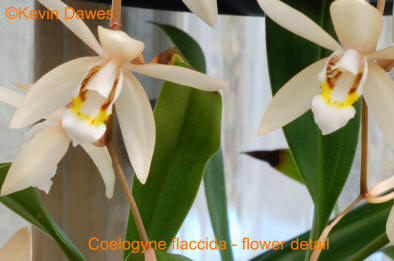Coelogyne flaccida, from Nepal through to China, Vietnam and Thailand, can be found at altitudes up to 2300m. The long pendulous racemes of creamy white flowers with yellow and brown markings make a spectacular display. As a further bonus, it has a pleasant mild perfume. If space is not a problem, this readily available plant can be grown into a beautiful specimen plant (i.e. a large plant with many flowers). The background image to all these pages is Coelogyne flaccida.
Coelogyne flaccida can be non-scientifically identified as such by examining the yellow bar across the lip. It should be a clean, simple bar with clear white on both sides of the bar. If there are patches of other colour on either side or if the bar is blurred or indistinct, then it is probably not Coelogyne flaccida but one of the species below (e.g. Coel huettneriana). Check the lip markings on the images of both flowers above for comparison.
Cultivation Suggestions: This Coelogyne definitely should be grown in a hanging basket as the racemes grow out longer than their pot. Despite its high altitude background, it should not be exposed to frost or direct light. Often high altitude winter climates may have deciduous trees that could let lots of light through but the sun is often frustrated by continual heavy fog layers/clouds. This same fog can keep the plant slightly moist during winter. It should be given plenty of water and kept in high humidity during the growing season and at the same time given a good pinch of slow release fertiliser every spring and autumn. Any well-drained, but moisture retentive media will keep it happy (as for most Coelogynes). I use medium coco chips.
Negatives: Some growers find this orchid a little temperamental about flowering well, despite it being tough and easy going. If this is the case in your collection, move it to a different location for 12 months - preferably, one with a little more light.
Rating: ♦♦♦♦♦ It is very easy to obtain and cheap and so worth a space in your home or garden.
Sometimes sold as: Coelogyne lactea is considered by some experts to be conspecific (i.e. the same) with Coelogyne flaccida. However, the RHS still has Coelogyne lactea listed as a separate species. Nurseries also frequently mislabel Coelogyne huettneriana as Coelogyne flaccida and vice versa.
Varieties: Whilst there are no botanical varieties identified, there are many slight variations in colour that have prompted their owners to add their own tag, i.e. Coelogyne flaccida 'Salmon'. Others are tagged 'Caramel', 'Dark', etc. These are not official name tags but are often handy for describing an individual plant. Cuttings from these plants will have the same flower colour as the original plant.
Hybrids: The floriferous habit of Coelogyne flaccida has encouraged a number of hybrids.
- Coelogyne Jannine Banks (David Banks 1995) - using Coelogyne mooreana as the pod parent.
- Coelogyne Shibata (Shibata 1923) - using Coelogyne speciosa as the pollen parent.
- Coelogyne Unchained Melody (David Banks1995) - using Coelogyne cristata as the pod parent.
- Coelogyne Kirribilli Susan Dixon (Kevin Dawes 2018) using Coelogyne huettneriana as the pod parent.
| < Coel fimbriata | Coel flexuosa > |

